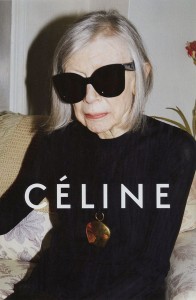For decades, models on the cover of most fashion magazines were rarely old enough to order a drink at a bar. In fact, most working models are still between 13 and 16 years old.
The world of high fashion is about youth, thinness and airbrushed perfection. A woman over the age of 50 has had no place in such a world, until now.
Legendary women ranging from Joni Mitchell to Helen Mirren are seeing their own time in the spotlight on some of the biggest fashion magazines in the business. It’s a small step towards accepting aging as a beautiful and natural process, but it’s one we couldn’t have imagined the high fashion industry making 50 years ago.
Iris Apfel leads the way in this fashion revolution. The 93-year-old is hard to miss with her enormous glasses, comically oversized accessories and fierce red lipstick. Even if you have no idea who she is (a hugely successful businesswoman and interior designer), you’ve probably seen her face somewhere. She has a fearless sense of fashion, choosing to stand out rather than fade into the background.
What makes this “aging trend” so fascinating to me is that it shouldn’t be a “trend” at all. For the most part, older women have a better sense of individual fashion than younger women. They have had many more years to decide what they like and dislike and they have the confidence to wear clothes a 20-something might find a little too out-of-the-box. Most of all, they usually have the expendable income to buy well-made designer labels, while women under 30 still shop for bargain wear. It would make sense for an older woman to be the face of high fashion.
Yet, women are taught early on that their worth in society only matters if they are thin, beautiful and young. While youth is a coveted trait across genders, women get hit with this expectation especially hard. A woman slowly becomes less visible and worthy in society as she ages–it’s a tiring trope that persists today.
Societies that fear death are also much less likely to embrace aging overall. Plastic surgery, diet pills and hormone supplements fight against this natural process. Ironically, in such an effort to stay young, many people actually shorten their own lives.
Actress Maggie Gyllenhaal argues that men get better roles as they age, while women prematurely become grandmothers. A 20-year-old woman can play the love interest of a 55-year-old man, yet a 37-year-old woman is more likely to be cast as the 55-year-old’s mother.
As women gain more power in society, these tropes change. High fashion is one example of an industry slowly embracing the dignity of age, and all of the wrinkles that come with it.

Twiggy modeling for Marks & Spencer at age 59
Credit: dailymail.co.uk
It’s no coincidence that the women featured in this article are powerful and successful in their own right. However, it’s still rare to see an average model over 30 on the cover of a magazine, and it will probably be a long time before it becomes common.
Historically, the fashion industry has placed older women and women of color in the background. Even with the new aging trend, this problem continues. The fashion industry as a whole still hires white teenage models the majority of the time for its campaigns. Even older women getting time in the limelight are mostly highly-successful, wealthy white women.
Yet these recent campaigns with Twiggy and Jessica Lange are one step in the right direction towards embracing age. As we see more powerful women embrace their age, our fear of getting that first strand of grey hair will start to fade. Women can see themselves as worth more than their physical appearance. No matter how old they are, they have something to offer.

 Old is the New Black
Old is the New Black




 “Help Me, Helen”
“Help Me, Helen”

 “As Tears Go By” by Marianne Faithfull
“As Tears Go By” by Marianne Faithfull














